
18 Results

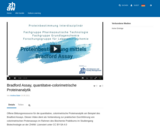
Quantitative, colorimetrische Proteinanalytik am Beispiel des Bradford Assays. Dieses Video dient als Vorbereitung zur praktischen Durchführung von colorimetrischen Proteinassay.
- Subject:
- Applied Science
- Health, Medicine and Nursing
- Material Type:
- Activity/Lab
- Author:
- Andrea Baier
- Date Added:
- 12/05/2022
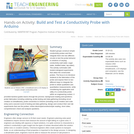
Student groups construct simple conductivity probes and then integrate them into two different circuits to test the probe behavior in solutions of varying conductivity (salt water, sugar water, distilled water, tap water). The activity culminates with student-designed experiments that utilize the constructed probes. The focus is to introduce students to the fabrication of the probe and expose them to two different ways to integrate the probe to obtain qualitative and quantitative measurements, while considering the application and utility of a conductivity probe within an engineering context. A provided handout guides teams through the process: background reading and questions; probe fabrication including soldering; probe testing and data gathering (including circuit creation on breadboard); probe connection to Arduino (including circuit creation and code entry) and a second round of testing and data gathering; design and conduct their own lab experiments that use the probes; online electrolyte/nonelectrolyte reading, short video, comprehension check and analysis questions.
- Subject:
- Career and Technical Education
- Chemistry
- Physical Science
- Material Type:
- Activity/Lab
- Provider:
- TeachEngineering
- Provider Set:
- TeachEngineering
- Author:
- Iulian Irimina
- Phillip Cook
- Date Added:
- 02/17/2017

Communicating With Data has a distinctive structure and content, combining fundamental quantitative techniques of using data to make informed management decisions with illustrations of how real decision makers, even highly trained professionals, fall prey to errors and biases in their understanding. We present the fundamental concepts underlying the quantitative techniques as a way of thinking, not just a way of calculating, in order to enhance decision-making skills. Rather than survey all of the techniques of management science, we stress those fundamental concepts and tools that we believe are most important for the practical analysis of management decisions, presenting the material as much as possible in the context of realistic business situations from a variety of settings. Exercises and examples drawn from marketing, finance, operations management, strategy, and other management functions.
- Subject:
- Applied Science
- Business and Communication
- Communication
- Computer Science
- Engineering
- Management
- Social Science
- Material Type:
- Full Course
- Provider:
- MIT
- Provider Set:
- MIT OpenCourseWare
- Author:
- Carroll, John
- Date Added:
- 06/01/2003
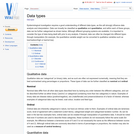
Epidemiological investigation requires a good understanding of different data types, as this will strongly influence data analysis and interpretation. Data can broadly be classified as qualitative and quantitative, and within each of these groups, data can be further categorised as shown below. Although different grouping systems are available, it is important to consider the type of data being dealt with prior to any analysis. If desired, data can often be changed into different types through manipulation (for example, the quantitative variable weight can be converted to qualitative variables such as low/medium/high or low/not low).
- Subject:
- Life Science
- Material Type:
- Diagram/Illustration
- Reading
- Provider:
- WikiVet
- Provider Set:
- Veterinary Epidemiology
- Date Added:
- 02/27/2015
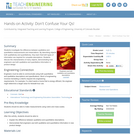
Students investigate the difference between qualitative and quantitative measurements and observations. By describing objects both qualitatively and quantitatively, they learn that both types of information are required for complete descriptions. Students discuss the characteristics of many objects, demonstrating how engineers use both qualitative and quantitative information in product design.
- Subject:
- Education
- Material Type:
- Activity/Lab
- Provider:
- TeachEngineering
- Provider Set:
- TeachEngineering
- Author:
- Denise W. Carlson
- Malinda Schaefer Zarske
- Megan Schroeder
- Date Added:
- 10/14/2015

In this lesson, we learn how insects can fly in the rain. The objective is to calculate the impact forces of raindrops on flying mosquitoes. Students will gain experience with using Newton's laws, gathering data from videos and graphs, and most importantly, the utility of making approximations. No calculus will be used in this lesson, but familiarity with torque and force balances is suggested. No calculators will be needed, but students should have pencil and paper to make estimations and, if possible, copies of the graphs provided with the lesson. Between lessons, students are recommended to discuss the assignments with their neighbors.
- Subject:
- Physical Science
- Physics
- Material Type:
- Activity/Lab
- Lecture Notes
- Lesson Plan
- Provider:
- MIT
- Provider Set:
- MIT Blossoms
- Author:
- David Hu
- Date Added:
- 10/29/2012
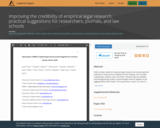
Fields closely related to empirical legal research are enhancing their methods to improve the credibility of their findings. This includes making data, analysis code, and other materials openly available, and preregistering studies. Empirical legal research appears to be lagging behind other fields. This may be due, in part, to a lack of meta-research and guidance on empirical legal studies. The authors seek to fill that gap by evaluating some indicators of credibility in empirical legal research, including a review of guidelines at legal journals. They then provide both general recommendations for researchers, and more specific recommendations aimed at three commonly used empirical legal methods: case law analysis, surveys, and qualitative studies. They end with suggestions for policies and incentive systems that may be implemented by journals and law schools.

The 15.821 and 15.822 Sequence
Marketing research may be divided into methods that emphasize understanding "the customer" and methods that emphasize understanding "the market." This course (15.821) deals with the customer and emphasizes qualitative methods (interviews, focus groups, Voice of the Customer, composing questions for a survey). The companion course (15.822) deals with the market and emphasizes quantitative methods (sampling, survey execution, quantitative data interpretation, conjoint analysis, factor analysis).
The methods covered in 15.821 are often used in the "front-end" of market research project, whose second-stage is a quantitative survey. The quality of information gathered in the second-stage is greatly enhanced in this way.
15.821 is designed for the nonspecialist, e.g., someone planning a career in general management, product or project management, R&D, advertising, or entrepreneurship. 15.822 teaches analytical techniques that are standard in consulting or marketing research, and is ideally suited for students planning careers in those fields.
- Subject:
- Business and Communication
- Communication
- Marketing
- Social Science
- Material Type:
- Full Course
- Provider:
- MIT
- Provider Set:
- MIT OpenCourseWare
- Author:
- Prelec, Drazen
- Date Added:
- 09/01/2002

This video lecture describes manpower planning process, various trends affecting HR demand forecasting. It also discusses quantitative and qualitative techniques of HR Demand forecasting.
- Subject:
- Arts and Humanities
- Business and Communication
- Career and Technical Education
- Management
- Material Type:
- Lecture
- Author:
- Dr. Chandrakanta Sahoo
- Date Added:
- 07/28/2021
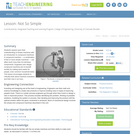
Students expand upon their understanding of simple machines with an introduction to compound machines. A compound machine a combination of two or more simple machines can affect work more than its individual components. Engineers who design compound machines aim to benefit society by lessening the amount of work that people exert for even common household tasks. This lesson encourages students to critically think about machine inventions and their role in our lives.
- Subject:
- Applied Science
- Engineering
- Physical Science
- Physics
- Material Type:
- Activity/Lab
- Lesson Plan
- Provider:
- TeachEngineering
- Provider Set:
- TeachEngineering
- Author:
- Janet Yowell
- Malinda Schaefer Zarske
- Michael Bendewald
- Date Added:
- 09/18/2014
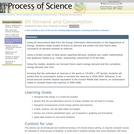
Data modeling activity using oil reserve and consumption data. Students predict when oil reserves meet or exceed reserves.
(Note: this resource was added to OER Commons as part of a batch upload of over 2,200 records. If you notice an issue with the quality of the metadata, please let us know by using the 'report' button and we will flag it for consideration.)
- Subject:
- Biology
- Geology
- Geoscience
- Life Science
- Mathematics
- Measurement and Data
- Physical Science
- Statistics and Probability
- Material Type:
- Activity/Lab
- Provider:
- Science Education Resource Center (SERC) at Carleton College
- Provider Set:
- Teach the Earth
- Author:
- Steve Iona
- Date Added:
- 02/17/2022
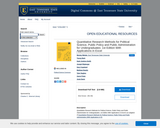
Quantitative Research Methods for Political Science, Public Policy and Public Administration for Undergraduates: 1st Edition With Applications in Excel is an adaption of Quantitative Research Methods for Political Science, Public Policy and Public Administration (With Applications in R). The focus of this book is on using quantitative research methods to test hypotheses and build theory in political science, public policy and public administration. This new version is designed specifically for undergraduate courses. It omits large portions of the original text that focused on calculus and linear algebra, expands and reorganizes the content on the software system by shifting to Excel and includes guided study questions at the end of each chapter.
- Subject:
- Political Science
- Social Science
- Material Type:
- Textbook
- Provider:
- East Tennessee State University
- Author:
- Aaron Fister
- Gary Copeland
- Hank Jenkins-Smith
- Joseph Ripberger
- Josie Davis
- Matthew Nowlin
- Tracey Bark
- Tyler Hughes
- Wehde Wesley
- Date Added:
- 07/02/2020

Quantitative Research Methods for Political Science, Public Policy and Public Administration for Undergraduates: 1st Edition With Applications in R is an adaption of Quantitative Research Methods for Political Science, Public Policy and Public Administration (With Applications in R). The focus of this book is on using quantitative research methods to test hypotheses and build theory in political science, public policy and public administration. This new version of the text omits large portions of the original text that focused on calculus and linear algebra, expands and reorganizes the content on the software system R and includes guided study questions at the end of each chapter.
- Subject:
- Political Science
- Social Science
- Material Type:
- Textbook
- Provider:
- East Tennessee State University
- Author:
- Aaron Fister
- Gary Copeland
- Hank Jenkins-Smith
- Joseph Ripberger
- Josie Davis
- Matthew Nowlin
- Tyler Hughes
- Wehde Wesley
- Date Added:
- 07/02/2020

Marketing research may be divided into methods that emphasize understanding "the customer" and methods that emphasize understanding "the market." This course (15.822) deals with the market. The companion course (15.821) deals with the customer.
The course will teach you how to write, conduct and analyze a marketing research survey. The emphasis will be on discovering market structure and segmentation, but you can pursue other project applications.
A major objective of the course is to give you some "hands-on" exposure to analysis techniques that are widely used in consulting and marketing research factor analysis, perceptual mapping, conjoint, and cluster analysis). These techniques used to be considered advanced but now involve just a few keystrokes on most stat software packages.
The course assumes familiarity with basic probability, statistics, and multiple linear regression.
- Subject:
- Business and Communication
- Marketing
- Material Type:
- Full Course
- Provider:
- MIT
- Provider Set:
- MIT OpenCourseWare
- Author:
- Prelec, Drazen
- Date Added:
- 09/01/2002

This graduate seminar introduces an emerging research program within International Relations on territorial conflict. While scholars have recognized that territory has been one of the most frequent issues over which states go to war, territorial conflicts have only recently become the subject of systematic study. This course will examine why territorial conflicts arise in the first place, why some of these conflicts escalate to high levels of violence and why other territorial disputes reach settlement, thereby reducing the likelihood of war. Readings in the course draw upon political geography and history as well as qualitative and quantitative approaches to political science.
- Subject:
- Arts and Humanities
- History
- Political Science
- Social Science
- Material Type:
- Full Course
- Provider:
- MIT
- Provider Set:
- MIT OpenCourseWare
- Author:
- Fravel, M.
- Date Added:
- 09/01/2004

This resource is a video abstract of a research paper created by Research Square on behalf of its authors. It provides a synopsis that's easy to understand, and can be used to introduce the topics it covers to students, researchers, and the general public. The video's transcript is also provided in full, with a portion provided below for preview:
"The interactions between viruses and prokaryotes play a key role in shaping microbiomes. However, little is known about the factors influencing host-virus interaction networks, especially when it comes to host factors. To close this gap, researchers constructed a host-provirus network out of over 7,000 species-level prokaryote genomes from many environments. Proviruses are virus genomes that have been integrated into the host genome, allowing researchers to detect them from available genomic datasets. Using this host-provirus network, the researchers then calculated the host interaction specialization, which quantifies how specialized a given host is in relation to the available interacting virus partners. Broadly, fast growing prokaryotes showed less virus specificity than slow growers. This negative growth rate-specialization relationship was widespread across the Earth’s microbiomes..."
The rest of the transcript, along with a link to the research itself, is available on the resource itself.
- Subject:
- Biology
- Life Science
- Material Type:
- Diagram/Illustration
- Reading
- Provider:
- Research Square
- Provider Set:
- Video Bytes
- Date Added:
- 04/14/2023
